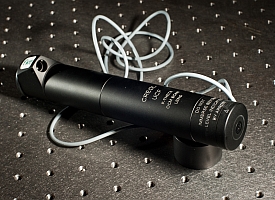An engineering professor at University of Rochester in New York has developed new medical optics that provide diagnostic images under the skin’s surface. Jannick Rolland discussed the technology on Saturday at the 2011 annual meeting of the American Association for the Advancement of Science in Washington, D.C..
Rolland’s technology aims to detect and examine skin lesions to determine whether they are benign or cancerous without having to cut the suspected tumor out of the skin and analyze it in the lab. Instead, the tip of a cylindrical probe (prototype pictured right) is placed in contact with the tissue. The foot-long probe produces high-resolution and three-dimensional images of what lies below the surface, usually in a few seconds.
The probe captures the images with a liquid lens developed by Rolland and her team for a process known as optical coherence microscopy. In a liquid lens, a small drop of water replaces the glass in a standard lens. As the electrical field around the water changes, the droplet changes its shape and therefore changes the focus of the lens.
The changing shape of the water and focus of the lens allow the device to take thousands of pictures focused at different depths below the skin’s surface. Combining these images creates a fully in-focus image of all of the tissue up to 1 millimeter deep in human skin, which includes important skin tissue structures. The use of near infrared light instead of ultrasound, eables the device to produce images at micron-scale resolution — 1 millionth of a meter — instead of a millimeter-scale (1 thousandth of a meter) resolution.
“In the future,” says Rolland, “this technology could remove significant inconvenience and expense from the process of skin lesion diagnosis.” Rolland hopes this imaging technology can for some patients replace surgical biopsies or expensive MRIs.
* * *


 RSS - Posts
RSS - Posts
[…] High-Res Optics Developed for Imaging Under the Skin […]
[…] Read more: High-Res Optics Developed for Imaging Under the Skin […]
I am a dermatologist !
I want to have a corporation with your company !
Give me all of your informations aboat Your diagnosstics and treat products.
My e-mail address is; etika_derm@hotmail.com
Thank you Cen for your comment and readership of Science Business. You probably want to talk to Dr. Jannick Rolland at University of Rochester who conducted the research. Her telephone number is +1 585-273-4040 and e-mail is rolland [at] optics [dot] rochester [dot] edu . Here’s Dr. Rolland’s Web page with more about her research … http://www.optics.rochester.edu/people/faculty/rolland_jannick/index.html – AK